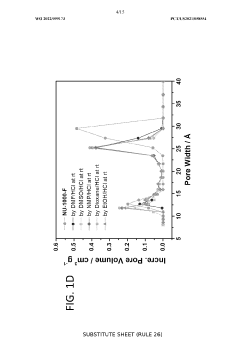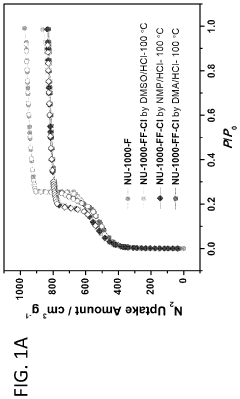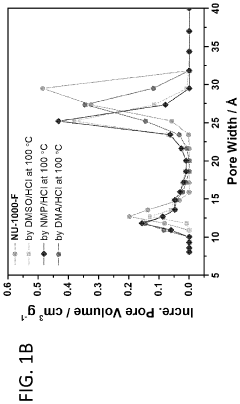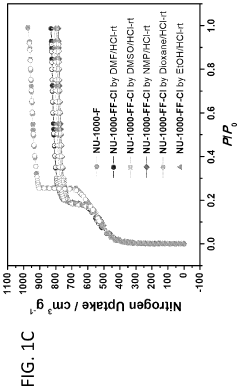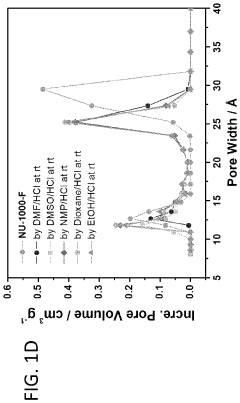Metal-Organic Frameworks in Atmospheric Water Harvesting Technologies
AUG 11, 20259 MIN READ
Generate Your Research Report Instantly with AI Agent
Patsnap Eureka helps you evaluate technical feasibility & market potential.
MOF-AWH Background and Objectives
Metal-Organic Frameworks (MOFs) have emerged as a promising class of materials for atmospheric water harvesting (AWH) technologies. The development of MOF-based AWH systems represents a significant advancement in addressing global water scarcity issues, particularly in arid and water-stressed regions.
The evolution of MOF-AWH technology can be traced back to the early 2000s when MOFs were first synthesized and characterized. Initially, MOFs were primarily explored for gas storage and separation applications. However, their exceptional porosity, high surface area, and tunable chemical properties soon attracted attention for water adsorption and desorption processes.
The primary objective of MOF-AWH technology is to efficiently extract water from the atmosphere, even in low humidity conditions, and convert it into potable water. This goal aligns with the United Nations Sustainable Development Goal 6, which aims to ensure availability and sustainable management of water and sanitation for all by 2030.
Recent years have witnessed significant progress in MOF-AWH research, driven by the urgent need for sustainable water solutions. Key milestones include the development of MOFs with enhanced water uptake capacity, improved hydrolytic stability, and faster adsorption-desorption kinetics. These advancements have led to the creation of MOF-based AWH devices capable of producing water in desert-like conditions.
The technical evolution of MOF-AWH systems has focused on several critical aspects. These include optimizing the pore size and chemistry of MOFs to maximize water uptake at low relative humidity, enhancing the thermal and cycling stability of MOFs to ensure long-term performance, and developing efficient heat management strategies to minimize energy consumption during the water harvesting process.
Current research trends in MOF-AWH technology are centered on scaling up laboratory prototypes to practical, field-deployable systems. This involves addressing challenges related to MOF synthesis and shaping, device engineering, and system integration. Additionally, efforts are being made to develop MOFs with improved selectivity for water over other atmospheric components and to enhance the overall energy efficiency of the AWH process.
The ultimate goal of MOF-AWH technology is to provide a decentralized, off-grid solution for clean water production that can operate effectively in diverse environmental conditions. This technology has the potential to revolutionize water access in remote areas, disaster-stricken regions, and water-scarce communities worldwide.
The evolution of MOF-AWH technology can be traced back to the early 2000s when MOFs were first synthesized and characterized. Initially, MOFs were primarily explored for gas storage and separation applications. However, their exceptional porosity, high surface area, and tunable chemical properties soon attracted attention for water adsorption and desorption processes.
The primary objective of MOF-AWH technology is to efficiently extract water from the atmosphere, even in low humidity conditions, and convert it into potable water. This goal aligns with the United Nations Sustainable Development Goal 6, which aims to ensure availability and sustainable management of water and sanitation for all by 2030.
Recent years have witnessed significant progress in MOF-AWH research, driven by the urgent need for sustainable water solutions. Key milestones include the development of MOFs with enhanced water uptake capacity, improved hydrolytic stability, and faster adsorption-desorption kinetics. These advancements have led to the creation of MOF-based AWH devices capable of producing water in desert-like conditions.
The technical evolution of MOF-AWH systems has focused on several critical aspects. These include optimizing the pore size and chemistry of MOFs to maximize water uptake at low relative humidity, enhancing the thermal and cycling stability of MOFs to ensure long-term performance, and developing efficient heat management strategies to minimize energy consumption during the water harvesting process.
Current research trends in MOF-AWH technology are centered on scaling up laboratory prototypes to practical, field-deployable systems. This involves addressing challenges related to MOF synthesis and shaping, device engineering, and system integration. Additionally, efforts are being made to develop MOFs with improved selectivity for water over other atmospheric components and to enhance the overall energy efficiency of the AWH process.
The ultimate goal of MOF-AWH technology is to provide a decentralized, off-grid solution for clean water production that can operate effectively in diverse environmental conditions. This technology has the potential to revolutionize water access in remote areas, disaster-stricken regions, and water-scarce communities worldwide.
Market Analysis for AWH Solutions
The atmospheric water harvesting (AWH) market is experiencing significant growth, driven by increasing water scarcity and the need for sustainable water solutions. As global climate change exacerbates water shortages in many regions, AWH technologies, particularly those utilizing Metal-Organic Frameworks (MOFs), are gaining traction as innovative solutions to address these challenges.
The market for AWH solutions is projected to expand rapidly in the coming years, with a focus on both residential and commercial applications. Regions facing severe water stress, such as the Middle East, North Africa, and parts of Asia, are expected to be key markets for AWH technologies. Additionally, there is growing interest in AWH solutions for disaster relief and remote area applications, further broadening the market potential.
MOF-based AWH technologies offer several advantages over traditional water harvesting methods, including higher efficiency, lower energy consumption, and the ability to operate in a wider range of environmental conditions. These benefits are driving increased investment in research and development, as well as attracting attention from both established water technology companies and innovative startups.
The market landscape for AWH solutions is diverse, encompassing various technologies and applications. While MOF-based systems are emerging as a promising segment, they compete with other AWH technologies such as cooling condensation, desiccant-based systems, and fog harvesting. Each technology has its strengths and target markets, contributing to a complex and dynamic competitive environment.
Consumer awareness and acceptance of AWH technologies are growing, particularly in water-stressed regions. However, challenges remain in terms of cost, scalability, and integration with existing water infrastructure. Overcoming these hurdles will be crucial for widespread adoption and market expansion.
Government initiatives and regulations promoting water conservation and sustainable technologies are expected to play a significant role in shaping the AWH market. Incentives for adopting water-efficient technologies and stricter water management policies are likely to drive demand for AWH solutions, including MOF-based systems.
The potential for MOF-based AWH technologies to address water scarcity in agriculture and industrial sectors presents additional market opportunities. As these sectors face increasing pressure to reduce water consumption and improve sustainability, innovative AWH solutions could find new applications and market niches.
The market for AWH solutions is projected to expand rapidly in the coming years, with a focus on both residential and commercial applications. Regions facing severe water stress, such as the Middle East, North Africa, and parts of Asia, are expected to be key markets for AWH technologies. Additionally, there is growing interest in AWH solutions for disaster relief and remote area applications, further broadening the market potential.
MOF-based AWH technologies offer several advantages over traditional water harvesting methods, including higher efficiency, lower energy consumption, and the ability to operate in a wider range of environmental conditions. These benefits are driving increased investment in research and development, as well as attracting attention from both established water technology companies and innovative startups.
The market landscape for AWH solutions is diverse, encompassing various technologies and applications. While MOF-based systems are emerging as a promising segment, they compete with other AWH technologies such as cooling condensation, desiccant-based systems, and fog harvesting. Each technology has its strengths and target markets, contributing to a complex and dynamic competitive environment.
Consumer awareness and acceptance of AWH technologies are growing, particularly in water-stressed regions. However, challenges remain in terms of cost, scalability, and integration with existing water infrastructure. Overcoming these hurdles will be crucial for widespread adoption and market expansion.
Government initiatives and regulations promoting water conservation and sustainable technologies are expected to play a significant role in shaping the AWH market. Incentives for adopting water-efficient technologies and stricter water management policies are likely to drive demand for AWH solutions, including MOF-based systems.
The potential for MOF-based AWH technologies to address water scarcity in agriculture and industrial sectors presents additional market opportunities. As these sectors face increasing pressure to reduce water consumption and improve sustainability, innovative AWH solutions could find new applications and market niches.
MOF-AWH Technical Challenges
Despite the promising potential of Metal-Organic Frameworks (MOFs) in Atmospheric Water Harvesting (AWH) technologies, several significant technical challenges persist. These challenges hinder the widespread adoption and commercialization of MOF-based AWH systems.
One of the primary obstacles is the optimization of MOF structures for efficient water adsorption and desorption cycles. While many MOFs exhibit high water uptake capacities, they often struggle with rapid and energy-efficient water release. This issue stems from the strong binding energies between water molecules and the MOF framework, necessitating substantial energy input for desorption. Researchers are actively exploring ways to fine-tune MOF pore sizes, functionalities, and hydrophilicity to achieve an optimal balance between water capture and release.
Another significant challenge lies in the scalability and cost-effectiveness of MOF synthesis. Many high-performance MOFs are currently produced using expensive precursors and complex synthesis procedures, limiting their large-scale production. Developing economically viable and environmentally friendly synthesis methods remains a crucial area of research. Additionally, ensuring the long-term stability and durability of MOFs under repeated adsorption-desorption cycles and varying atmospheric conditions poses a considerable challenge.
The integration of MOFs into practical AWH devices presents its own set of technical hurdles. Designing efficient heat transfer mechanisms within MOF-based adsorption beds, optimizing airflow patterns, and minimizing pressure drops are critical aspects that require further investigation. Moreover, the development of compact, lightweight, and energy-efficient AWH systems that can operate effectively in diverse climatic conditions remains a significant engineering challenge.
Environmental concerns also play a role in the technical challenges faced by MOF-AWH technologies. Ensuring the biocompatibility and environmental safety of MOFs, particularly when used in drinking water applications, is crucial. This includes addressing potential leaching of metal ions or organic linkers from the MOF structure and assessing any long-term environmental impacts.
Lastly, the performance gap between laboratory-scale demonstrations and real-world applications presents a substantial challenge. Translating the impressive water harvesting capabilities observed in controlled laboratory conditions to practical, field-deployable systems that can operate reliably in varying atmospheric conditions requires significant research and development efforts. This includes addressing issues such as contaminant management, system robustness, and adaptability to fluctuating humidity levels and temperatures.
One of the primary obstacles is the optimization of MOF structures for efficient water adsorption and desorption cycles. While many MOFs exhibit high water uptake capacities, they often struggle with rapid and energy-efficient water release. This issue stems from the strong binding energies between water molecules and the MOF framework, necessitating substantial energy input for desorption. Researchers are actively exploring ways to fine-tune MOF pore sizes, functionalities, and hydrophilicity to achieve an optimal balance between water capture and release.
Another significant challenge lies in the scalability and cost-effectiveness of MOF synthesis. Many high-performance MOFs are currently produced using expensive precursors and complex synthesis procedures, limiting their large-scale production. Developing economically viable and environmentally friendly synthesis methods remains a crucial area of research. Additionally, ensuring the long-term stability and durability of MOFs under repeated adsorption-desorption cycles and varying atmospheric conditions poses a considerable challenge.
The integration of MOFs into practical AWH devices presents its own set of technical hurdles. Designing efficient heat transfer mechanisms within MOF-based adsorption beds, optimizing airflow patterns, and minimizing pressure drops are critical aspects that require further investigation. Moreover, the development of compact, lightweight, and energy-efficient AWH systems that can operate effectively in diverse climatic conditions remains a significant engineering challenge.
Environmental concerns also play a role in the technical challenges faced by MOF-AWH technologies. Ensuring the biocompatibility and environmental safety of MOFs, particularly when used in drinking water applications, is crucial. This includes addressing potential leaching of metal ions or organic linkers from the MOF structure and assessing any long-term environmental impacts.
Lastly, the performance gap between laboratory-scale demonstrations and real-world applications presents a substantial challenge. Translating the impressive water harvesting capabilities observed in controlled laboratory conditions to practical, field-deployable systems that can operate reliably in varying atmospheric conditions requires significant research and development efforts. This includes addressing issues such as contaminant management, system robustness, and adaptability to fluctuating humidity levels and temperatures.
Current MOF-AWH Approaches
01 MOF structures for water harvesting
Metal-Organic Frameworks (MOFs) are designed with specific structures to enhance water adsorption and desorption capabilities. These structures can be tailored to optimize pore size, surface area, and hydrophilicity, allowing for efficient water capture from the atmosphere even in low humidity conditions.- MOF structures for water harvesting: Metal-Organic Frameworks (MOFs) are designed with specific pore sizes and functionalities to efficiently capture water molecules from the atmosphere. These structures can be tailored to optimize water adsorption and desorption processes, making them highly effective for water harvesting applications in various environmental conditions.
- Adsorption-desorption cycle optimization: Researchers focus on improving the adsorption-desorption cycle of MOFs for water harvesting. This involves enhancing the kinetics of water uptake and release, as well as optimizing the energy requirements for the regeneration process. The goal is to increase the overall efficiency and water yield of the system.
- Integration of MOFs with other technologies: MOFs are being integrated with other technologies such as solar panels, heat exchangers, and advanced control systems to create more efficient and sustainable water harvesting solutions. These integrated systems aim to maximize water production while minimizing energy consumption and environmental impact.
- Scalability and durability of MOF-based systems: Efforts are being made to improve the scalability and durability of MOF-based water harvesting systems. This includes developing methods for large-scale MOF synthesis, enhancing the mechanical and chemical stability of MOFs, and designing systems that can operate efficiently in diverse environmental conditions over extended periods.
- Novel MOF compositions for enhanced performance: Researchers are exploring new MOF compositions and hybrid materials to enhance water harvesting performance. This includes incorporating hydrophilic functional groups, developing hierarchical structures, and creating composite materials that combine the advantages of different MOFs or other porous materials.
02 Functionalization of MOFs for improved water harvesting
MOFs can be functionalized with various chemical groups to enhance their water harvesting performance. This includes the incorporation of hydrophilic functional groups or the modification of metal nodes to increase water affinity and improve the overall water harvesting efficiency.Expand Specific Solutions03 Integration of MOFs in water harvesting devices
MOFs are integrated into specialized devices designed for atmospheric water harvesting. These devices may include components for air flow management, temperature control, and water collection systems to maximize the water yield from MOF-based adsorbents.Expand Specific Solutions04 Regeneration and cycling of MOF adsorbents
Techniques for regenerating MOF adsorbents after water harvesting cycles are developed to ensure long-term performance and efficiency. This may involve heating, pressure swing, or other methods to desorb water and prepare the MOF for subsequent adsorption cycles.Expand Specific Solutions05 Composite materials incorporating MOFs for water harvesting
Composite materials that combine MOFs with other materials such as polymers or inorganic substrates are developed to enhance water harvesting capabilities. These composites may offer improved stability, processability, or synergistic effects in water adsorption and desorption processes.Expand Specific Solutions
Key Players in MOF-AWH Research
The Metal-Organic Frameworks (MOFs) in Atmospheric Water Harvesting Technologies sector is in an early growth stage, with increasing research and development activities. The market size is expanding as water scarcity becomes a global concern, driving innovation in this field. Technologically, MOFs for water harvesting are still evolving, with varying levels of maturity across different applications. Key players like The University of California, Zhejiang University, and Water Harvesting, Inc. are leading research efforts, while institutions such as MIT, Northwestern University, and King Abdullah University of Science & Technology are contributing significant advancements. Industry collaboration with companies like Sumitomo Chemical Co., Ltd. and ExxonMobil Technology & Engineering Co. is accelerating the transition from lab-scale to practical applications.
The Regents of the University of California
Technical Solution: The University of California has developed an innovative MOF-based AWH technology that focuses on maximizing water yield while minimizing energy consumption. Their approach utilizes a zirconium-based MOF, MOF-801, which demonstrates excellent hydrolytic stability and high water uptake capacity[7]. The system incorporates a novel thermal management strategy, using low-grade heat sources to drive the water desorption process. This innovation significantly reduces the energy requirements for water production. The UC technology also features a unique water collection mechanism that minimizes losses during the condensation phase, improving overall system efficiency[8]. Their AWH device can operate effectively in relative humidity conditions as low as 20%, making it suitable for deployment in water-scarce regions[9].
Strengths: High energy efficiency, effective operation in low humidity conditions, and potential for integration with existing infrastructure. Weaknesses: Possible challenges in scaling up production of specialized MOF materials, and initial costs may be high for large-scale implementations.
Zhejiang University
Technical Solution: Zhejiang University has made significant advancements in MOF-based AWH technologies, focusing on enhancing water uptake capacity and system efficiency. Their research team has developed a novel composite MOF material that combines high water adsorption properties with improved thermal conductivity[12]. This innovation allows for more efficient heat transfer during the desorption process, leading to increased water production rates. The university's AWH system incorporates a unique solar-thermal design, utilizing concentrated solar power to drive the water extraction process. This approach significantly reduces the reliance on external energy sources, making the technology more sustainable and cost-effective[13]. Zhejiang University's AWH device also features an advanced water collection and purification system, ensuring the production of high-quality potable water suitable for various applications.
Strengths: High water production efficiency, integration of renewable energy sources, and potential for low operational costs. Weaknesses: Possible challenges in large-scale production of specialized composite MOF materials, and performance may vary in low-light conditions.
Breakthrough MOF-AWH Technologies
Ion-based methods for stabilizing and improving porous metal-organic framework (MOF) materials for water harvesting from air and related applications
PatentWO2022099173A1
Innovation
- Development of MOFs with positively charged linker unsaturated nodes and freely moving charge-compensating anions that are not bonded via coordination, allowing for high water-uptake capacity and mechanical stability during water release, achieved by synthesizing MOFs with protonated nodes and mobile chloride ions.
Ion-based methods for stabilizing and improving porous metal-organic framework (MOF) materials for water harvesting from air and related applications
PatentPendingUS20230416282A1
Innovation
- Developing MOFs with positively charged linker unsaturated nodes and freely moving charge-compensating anions that are not bonded via coordination, allowing for high water-uptake capacity and stability during water vapor uptake and release, achieved by synthesizing MOFs with a net positive charge and charge-compensating anions that remain solvated and mobile within the framework.
Environmental Impact of MOF-AWH
The environmental impact of Metal-Organic Frameworks (MOFs) in Atmospheric Water Harvesting (AWH) technologies is a critical aspect to consider as these systems gain traction in addressing global water scarcity issues. MOF-AWH systems offer a promising solution for sustainable water production, particularly in arid and water-stressed regions. However, their widespread implementation necessitates a comprehensive assessment of their environmental footprint.
One of the primary environmental benefits of MOF-AWH technologies is their potential to reduce reliance on traditional water sources, such as groundwater extraction or desalination, which often have significant ecological consequences. By harvesting water from the atmosphere, these systems can help preserve natural water bodies and aquifers, contributing to the overall health of ecosystems.
The energy efficiency of MOF-AWH systems is another crucial factor in their environmental impact. Many MOF materials exhibit high water uptake capacities and low regeneration temperatures, which translates to lower energy consumption compared to conventional water production methods. This reduced energy demand can lead to decreased greenhouse gas emissions, especially when coupled with renewable energy sources.
However, the production and disposal of MOFs themselves must be carefully evaluated. The synthesis of MOFs often involves the use of organic solvents and metal precursors, which can have environmental implications if not properly managed. Researchers are actively working on developing greener synthesis methods and exploring the use of bio-based precursors to mitigate these concerns.
The longevity and recyclability of MOF materials in AWH applications also play a significant role in their overall environmental impact. Durable MOFs that maintain their performance over numerous adsorption-desorption cycles can minimize the need for frequent replacements, reducing waste generation and resource consumption. Additionally, end-of-life considerations for MOF materials, including potential recycling or safe disposal methods, are essential areas of ongoing research.
The scalability of MOF-AWH technologies presents both opportunities and challenges from an environmental perspective. While large-scale implementation could significantly contribute to sustainable water production, it also raises questions about the potential impacts on local microclimates and atmospheric moisture levels. Careful monitoring and modeling of these effects will be crucial as the technology expands.
In conclusion, while MOF-AWH technologies show great promise for environmentally friendly water production, a holistic approach to assessing their environmental impact is necessary. This includes considering the entire lifecycle of MOF materials, from synthesis to disposal, as well as the broader ecological implications of widespread atmospheric water harvesting. Continued research and development in this field should prioritize optimizing the environmental performance of MOF-AWH systems to ensure their role in sustainable water management.
One of the primary environmental benefits of MOF-AWH technologies is their potential to reduce reliance on traditional water sources, such as groundwater extraction or desalination, which often have significant ecological consequences. By harvesting water from the atmosphere, these systems can help preserve natural water bodies and aquifers, contributing to the overall health of ecosystems.
The energy efficiency of MOF-AWH systems is another crucial factor in their environmental impact. Many MOF materials exhibit high water uptake capacities and low regeneration temperatures, which translates to lower energy consumption compared to conventional water production methods. This reduced energy demand can lead to decreased greenhouse gas emissions, especially when coupled with renewable energy sources.
However, the production and disposal of MOFs themselves must be carefully evaluated. The synthesis of MOFs often involves the use of organic solvents and metal precursors, which can have environmental implications if not properly managed. Researchers are actively working on developing greener synthesis methods and exploring the use of bio-based precursors to mitigate these concerns.
The longevity and recyclability of MOF materials in AWH applications also play a significant role in their overall environmental impact. Durable MOFs that maintain their performance over numerous adsorption-desorption cycles can minimize the need for frequent replacements, reducing waste generation and resource consumption. Additionally, end-of-life considerations for MOF materials, including potential recycling or safe disposal methods, are essential areas of ongoing research.
The scalability of MOF-AWH technologies presents both opportunities and challenges from an environmental perspective. While large-scale implementation could significantly contribute to sustainable water production, it also raises questions about the potential impacts on local microclimates and atmospheric moisture levels. Careful monitoring and modeling of these effects will be crucial as the technology expands.
In conclusion, while MOF-AWH technologies show great promise for environmentally friendly water production, a holistic approach to assessing their environmental impact is necessary. This includes considering the entire lifecycle of MOF materials, from synthesis to disposal, as well as the broader ecological implications of widespread atmospheric water harvesting. Continued research and development in this field should prioritize optimizing the environmental performance of MOF-AWH systems to ensure their role in sustainable water management.
Scalability of MOF-AWH Systems
The scalability of Metal-Organic Framework (MOF) based Atmospheric Water Harvesting (AWH) systems is a critical factor in determining their potential for widespread adoption and practical implementation. As research progresses, the focus has shifted from laboratory-scale demonstrations to larger, more commercially viable systems.
One of the primary challenges in scaling up MOF-AWH systems is maintaining the high water adsorption capacity and efficiency observed in small-scale experiments. As the size of the system increases, issues such as heat and mass transfer limitations become more pronounced. These limitations can significantly impact the overall performance and water yield of larger systems.
To address these challenges, researchers are exploring various approaches to enhance the scalability of MOF-AWH systems. One promising direction is the development of advanced MOF architectures that facilitate improved heat and mass transfer. This includes the design of hierarchical pore structures and the incorporation of heat-conducting materials to enhance thermal management.
Another important aspect of scalability is the optimization of the MOF synthesis process for large-scale production. Current methods often involve time-consuming and costly procedures that are not suitable for industrial-scale manufacturing. Efforts are underway to develop more efficient and cost-effective synthesis techniques, such as continuous flow processes and mechanochemical methods.
The integration of MOF-AWH systems with existing infrastructure is also crucial for scalability. Researchers are investigating ways to incorporate these systems into buildings, agricultural settings, and water treatment facilities. This integration requires careful consideration of factors such as energy consumption, maintenance requirements, and overall system efficiency.
Economic viability is a key factor in the scalability of MOF-AWH technologies. As systems increase in size, the cost per unit of water produced must decrease to make them competitive with alternative water sources. This necessitates ongoing efforts to reduce material costs, improve system durability, and optimize operational efficiency.
Environmental considerations also play a role in the scalability of MOF-AWH systems. As these technologies are deployed on a larger scale, it is essential to assess their long-term environmental impact, including the sustainability of MOF production and the potential effects on local ecosystems.
In conclusion, while significant progress has been made in demonstrating the potential of MOF-AWH systems at small scales, numerous challenges remain in scaling up these technologies for widespread use. Ongoing research and development efforts are focused on addressing these challenges to realize the full potential of MOF-AWH systems in addressing global water scarcity issues.
One of the primary challenges in scaling up MOF-AWH systems is maintaining the high water adsorption capacity and efficiency observed in small-scale experiments. As the size of the system increases, issues such as heat and mass transfer limitations become more pronounced. These limitations can significantly impact the overall performance and water yield of larger systems.
To address these challenges, researchers are exploring various approaches to enhance the scalability of MOF-AWH systems. One promising direction is the development of advanced MOF architectures that facilitate improved heat and mass transfer. This includes the design of hierarchical pore structures and the incorporation of heat-conducting materials to enhance thermal management.
Another important aspect of scalability is the optimization of the MOF synthesis process for large-scale production. Current methods often involve time-consuming and costly procedures that are not suitable for industrial-scale manufacturing. Efforts are underway to develop more efficient and cost-effective synthesis techniques, such as continuous flow processes and mechanochemical methods.
The integration of MOF-AWH systems with existing infrastructure is also crucial for scalability. Researchers are investigating ways to incorporate these systems into buildings, agricultural settings, and water treatment facilities. This integration requires careful consideration of factors such as energy consumption, maintenance requirements, and overall system efficiency.
Economic viability is a key factor in the scalability of MOF-AWH technologies. As systems increase in size, the cost per unit of water produced must decrease to make them competitive with alternative water sources. This necessitates ongoing efforts to reduce material costs, improve system durability, and optimize operational efficiency.
Environmental considerations also play a role in the scalability of MOF-AWH systems. As these technologies are deployed on a larger scale, it is essential to assess their long-term environmental impact, including the sustainability of MOF production and the potential effects on local ecosystems.
In conclusion, while significant progress has been made in demonstrating the potential of MOF-AWH systems at small scales, numerous challenges remain in scaling up these technologies for widespread use. Ongoing research and development efforts are focused on addressing these challenges to realize the full potential of MOF-AWH systems in addressing global water scarcity issues.
Unlock deeper insights with Patsnap Eureka Quick Research — get a full tech report to explore trends and direct your research. Try now!
Generate Your Research Report Instantly with AI Agent
Supercharge your innovation with Patsnap Eureka AI Agent Platform!



